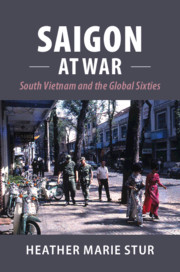Book contents
- Saigon at War
- Cambridge Studies in US Foreign Relations
- Saigon at War
- Copyright page
- Dedication
- Contents
- Figures
- Acknowledgments
- Introduction
- 1 The Heart of South Vietnam
- 2 A Tradition of Activism
- 3 South Vietnam’s Sixties Youth
- 4 South Vietnam and the World
- 5 Building Connections between the People and the Government
- 6 Saigon after Tet
- 7 The Catholic Opposition and Political Repression
- 8 Saigon in the Seventies
- Conclusion
- Select Bibliography
- Index
5 - Building Connections between the People and the Government
Published online by Cambridge University Press: 15 May 2020
- Saigon at War
- Cambridge Studies in US Foreign Relations
- Saigon at War
- Copyright page
- Dedication
- Contents
- Figures
- Acknowledgments
- Introduction
- 1 The Heart of South Vietnam
- 2 A Tradition of Activism
- 3 South Vietnam’s Sixties Youth
- 4 South Vietnam and the World
- 5 Building Connections between the People and the Government
- 6 Saigon after Tet
- 7 The Catholic Opposition and Political Repression
- 8 Saigon in the Seventies
- Conclusion
- Select Bibliography
- Index
Summary
It had been more than a week in May 1965 since Dang Nguyet Anh had learned that the Viet Cong had launched an attack in Phuoc Long province, where her husband, Second Lieutenant Nguyen Thanh Trac, was stationed at a military training center. In the time that passed, she did not hear from him, and the waiting soon became more than she should bear. So she took a local bus to the town of Dong Xoai in Phuoc Long province, and from there, she got a lift on an army vehicle heading to the training center where she believed her husband to be. On the way, VC troops attacked the vehicle, and Mrs. Anh was shot in both arms and suffered a broken foot. From her hospital bed in Saigon, she wrote a letter to South Vietnam’s Ministry of National Defense, asking that her husband be transferred to the city so that he could help take care of their six children, the oldest of whom was eight. Mrs. Anh was still nursing the youngest two, and she had no relatives to help her with child care. While recovering from her war wounds, she needed help more than ever.
- Type
- Chapter
- Information
- Saigon at WarSouth Vietnam and the Global Sixties, pp. 152 - 173Publisher: Cambridge University PressPrint publication year: 2020

